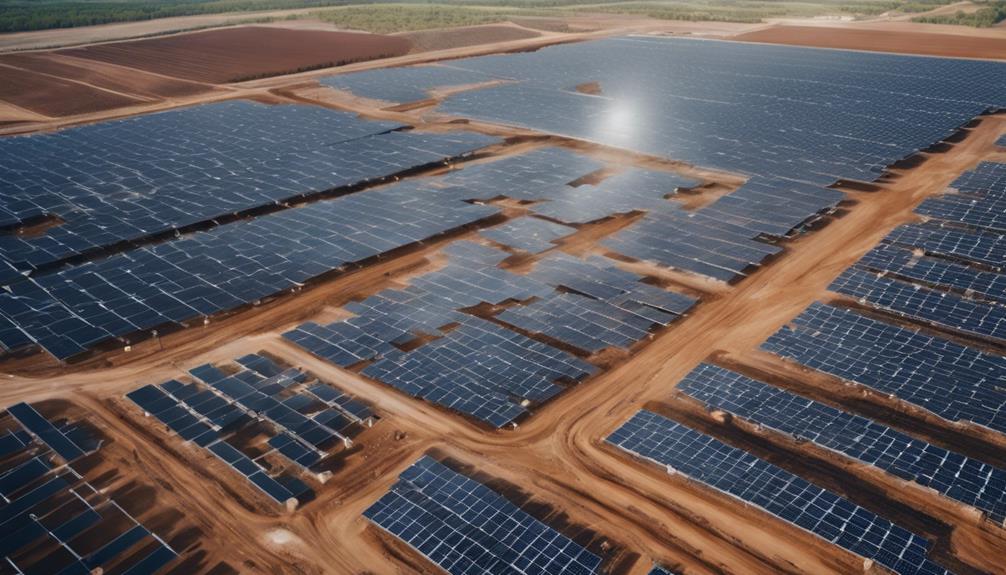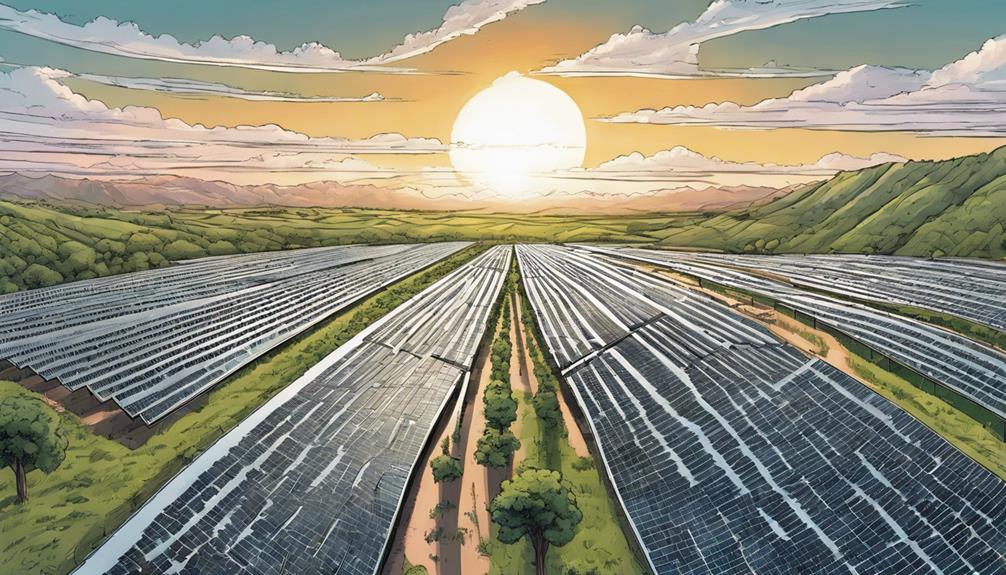Discover top strategies like best site selection, proper panel orientation, and advanced technologies to guarantee solar farm success. Improve efficiency with tracking systems and energy storage solutions for consistent power output. Financially, consider power purchase agreements and effective cost management for profitability. Boost energy generation with solar trackers and explore innovations like floating solar farms for enhanced performance. Understand cost variations and soft costs like permitting for budgeting accuracy. Effective site scouting and module configuration maximize solar capture. Explore solar investment funds and innovative financing methods for feasibility assessment. Delve into this guide for the ultimate solar farm construction practices and advancements.
Key Takeaways
- Optimal site selection and scouting for high solar irradiance.
- Implement advanced solar technologies for efficiency optimization.
- Utilize Battery Energy Storage Systems (BESS) for consistent power output.
- Compliance with industry regulations and standards is crucial.
- Advanced technologies like solar trackers boost efficiency by up to 30%.
Site Selection and Scouting
When selecting a site for your solar farm, thorough scouting is vital to guarantee ideal sun exposure and maximize energy production. Site selection plays an important role in determining the solar irradiance potential of your project. Factors such as shading, topography, and access to transmission lines need to be carefully evaluated to ensure efficient construction and operation of the solar farm.
Identifying locations with best sun angles is key to maximizing the performance and profitability of your solar energy project.
Utilizing advanced tools like GIS technology and solar mapping software can aid in evaluating the solar potential of different sites. These tools provide valuable insights into sun exposure patterns, helping you choose the most suitable location for your solar farm.
Module Configuration for Solar Capture
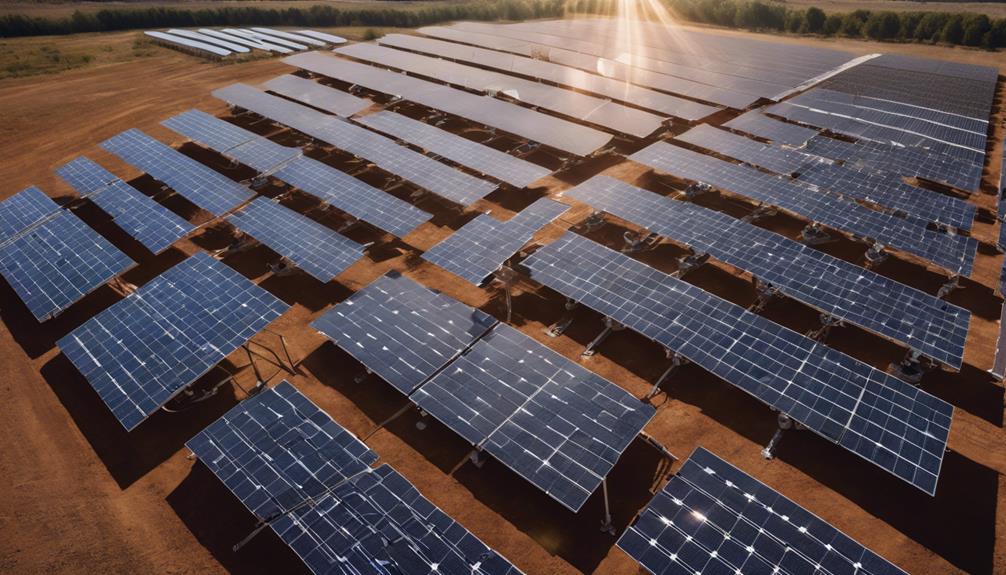
When configuring solar modules for best energy capture, focusing on panel tilt optimization and spacing efficiency is important.
By strategically adjusting the tilt angle of panels and optimizing their spacing, you can enhance solar capture throughout the year.
These simple yet effective solutions can greatly boost energy output and maximize the efficiency of your solar farm.
Panel Tilt Optimization
To optimize solar capture efficiency, adjusting the tilt angle of solar panels is essential for maximizing sunlight exposure throughout the year. Panel tilt optimization plays a crucial role in enhancing energy production by up to 20% when compared to fixed panels. The optimal tilt angle of solar panels varies depending on the geographic location to ensure maximum solar energy capture. Seasonal adjustments are commonly made to the tilt angles to account for the changing position of the sun in the sky. Utilizing advanced solar design software can aid in calculating the ideal panel tilt angles specific to each location, thereby optimizing energy generation.
| Considerations | Description |
|---|---|
| Geographic Location | Determines the optimal tilt angle for solar panels to maximize sunlight exposure. |
| Seasonal Adjustments | Regularly changing panel tilt angles based on the sun's position in different seasons. |
| Advanced Design Software | Utilized to calculate precise panel tilt angles, enhancing energy generation efficiency. |
Spacing Efficiency Solutions
For best solar capture efficiency, implementing strategic module spacing solutions is important in maximizing energy production in a solar farm. Proper module spacing plays a vital role in reducing shading and optimizing solar capture, leading to enhanced energy production.
By focusing on efficient module configuration, solar farm designers can greatly impact the overall performance and profitability of the installation. Advanced tools like pvDesign software offer precise solutions for module layout, considering factors such as tilt angle, row spacing, and orientation to maximize energy yield.
Strategic placement of solar modules also helps in minimizing inter-row shading, further boosting energy production. This emphasis on spacing efficiency solutions within the solar farm design guide is crucial for shading reduction and energy production optimization.
Implementing these best practices ensures that the solar farm operates at its highest potential, translating into increased profitability and sustainable energy generation.
Technology Selection for Solar Farms
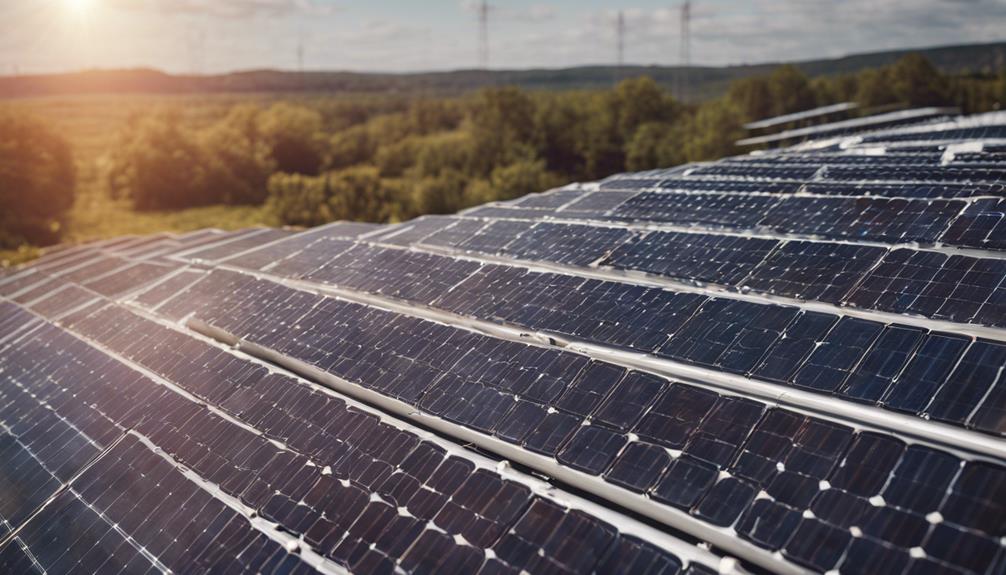
Selecting the appropriate technology components is vital for optimizing the efficiency and performance of solar farms. When building a solar farm, choosing the right solar modules, inverters, mounting structures, transformers, and advanced technologies is essential for maximizing energy generation and guaranteeing grid compatibility. Here's a breakdown of key technology components for solar farms:
| Technology Component | Description | Importance |
|---|---|---|
| Solar Modules | High-efficiency monocrystalline panels | Optimize energy generation |
| Inverter Choice | String inverters for smaller projects, central inverters for utility-scale | Enhance energy conversion |
| Mounting Structures | Fixed-tilt or tracking systems | Maximize solar exposure |
| Transformers | Critical for voltage conversion and grid compatibility | Ensure seamless energy distribution |
| Advanced Technologies | Bifacial panels, smart inverters | Improve overall performance |
Choosing the right mix of these technologies will not only boost the efficiency of your solar farm but also contribute to its long-term success and sustainability.
Solar Farm Monetization Guide
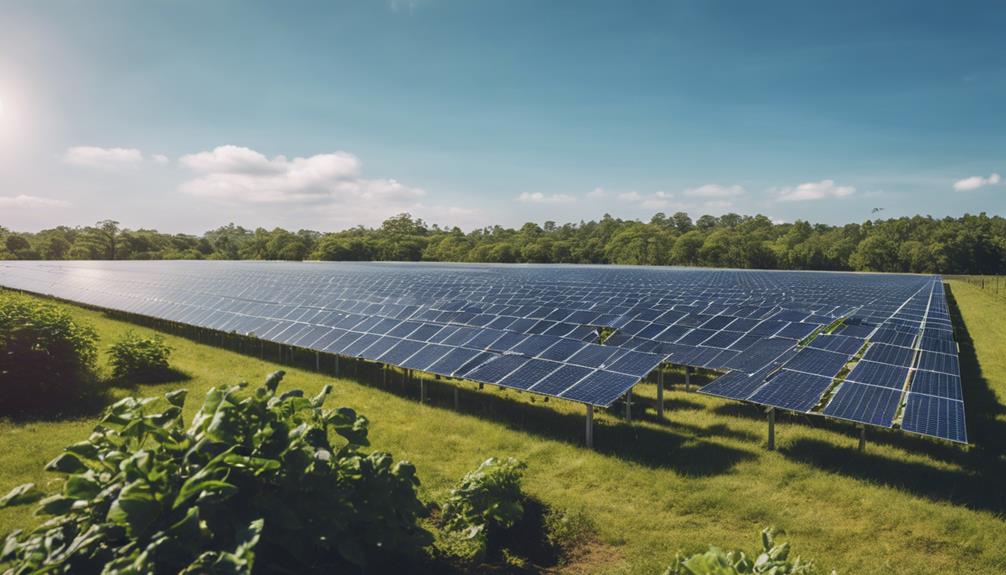
Maximize your land's capacity by generating long-term income through the establishment of utility-scale solar farms. In the domain of solar farm monetization, key strategies include utilizing Power Purchase Agreements (PPAs) and selling surplus energy to the grid. These methods guarantee a consistent revenue flow and boost profitability.
Developing a sound financial strategy is vital for successful income generation. By monetizing your land for solar farm establishment, you can access the economic growth and job creation linked to the renewable energy sector.
To optimize revenue potential, it's crucial to secure financing, manage costs efficiently, and streamline operations. This entails comprehending the grid connection process, solar irradiance levels, and selecting the appropriate technology for the best panel arrangement. By concentrating on these aspects, you can enhance profitability and guarantee long-term success in the utility-scale solar industry.
Investing in solar farm establishment not only provides financial advantages but also contributes to environmental sustainability and enduring returns.
Solar Farm Efficiency Essentials
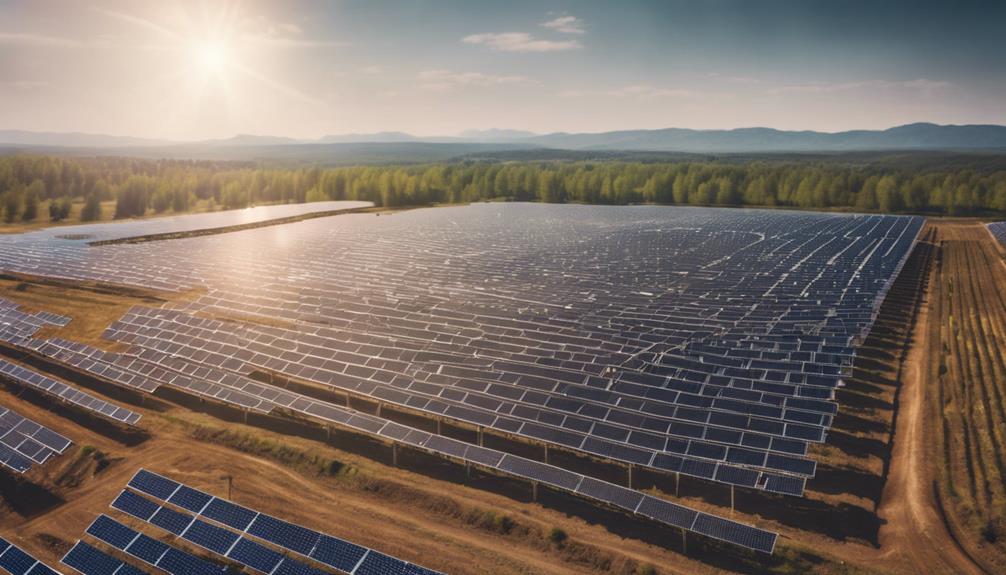
To optimize the efficiency of your solar farm, focus on implementing advanced solar technologies and efficiency optimization techniques. By carefully considering factors like panel orientation, tilt angle, and spacing, you can maximize power output and profitability.
Explore the benefits of advanced inverters, tracking systems, and innovative layouts to enhance the overall performance of your solar farm.
Efficiency Optimization Techniques
By implementing strategic panel tilt, orientation, and spacing, you can enhance the efficiency of your solar farm, maximizing energy capture potential. Proper panel tilt, orientation, and spacing can boost solar capture efficiency by up to 25%.
In addition, integrating advanced tracking systems can further enhance efficiency by up to 30% compared to fixed-tilt systems. To optimize energy production and storage, consider incorporating Battery Energy Storage Systems (BESS) for consistent power output.
State-of-the-art inverters play an essential role in improving energy conversion efficiency and overall system performance. Moreover, advanced monitoring and control systems can enhance operational efficiency, aiding in maintenance planning and ensuring smooth operations for your solar farm.
Advanced Solar Technologies
Implementing advanced solar technologies is vital for enhancing the efficiency and productivity of your solar farm. By incorporating cutting-edge solar technologies such as bifacial solar panels, solar trackers, floating solar farms, thin-film solar panels, and microinverter systems, you can greatly boost energy generation and overall efficiency.
Bifacial solar panels have the potential to increase energy generation by up to 25% compared to traditional panels, maximizing the output of your solar farm. Solar trackers play a pivotal role in improving efficiency by tracking the sun's path throughout the day, leading to a 20-25% increase in energy output.
Floating solar farms offer enhanced efficiency by leveraging cooler panel temperatures and alleviating land constraints, making them a viable option for maximizing energy production. Thin-film solar panels are lightweight and flexible, making them ideal for areas with irregular or limited land availability, ultimately enhancing the efficiency of your solar farm.
Integrated microinverter systems further optimize energy production by managing individual solar panels, minimizing energy losses, and improving overall system efficiency. Incorporating these advancements in solar technologies is essential for achieving peak performance in your solar farm.
Solar Farm Costs Demystified
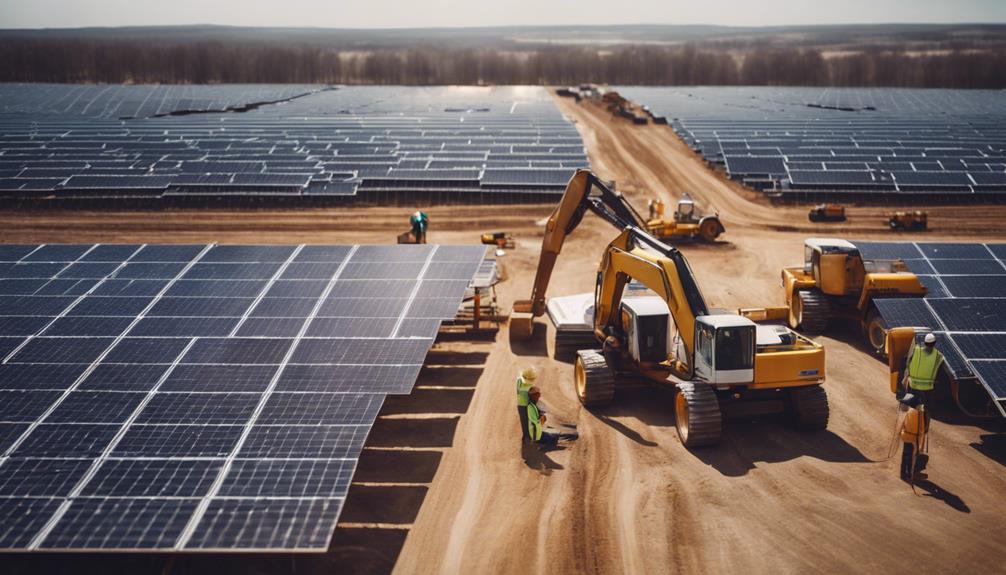
Understanding the costs of building a solar farm can be intricate due to various influencing factors. Here are some key points to keep in mind:
- Solar farm costs can vary: Depending on factors like size, location, technology, and permitting requirements, costs can fluctuate significantly.
- Decrease in solar panel costs: The cost of solar panels has decreased notably in the past decade, making solar farm projects more economical.
- Average costs for utility-scale solar farms: These range from $1 to $3 per watt, with larger projects generally costing less per watt.
- Soft costs importance: Soft costs like permitting, financing, and interconnection can make up a significant portion of overall solar farm expenses.
Proper budgeting and using cost-tracking tools are essential in managing expenses effectively during the construction of a solar farm. By understanding these cost dynamics, you can make informed decisions to keep your solar farm project within budget.
Financing Options and Advancements

Exploring various financing options and advancements is essential for securing investments in solar farm projects. Solar farm financing encompasses grants, loans, tax incentives, and power purchase agreements to attract investors. Advancements in financial tools such as solar investment funds and crowdfunding platforms provide diverse investment opportunities. Financial models and templates play a crucial role in assessing the feasibility and returns of solar projects, aiding in optimizing investments. It is imperative to understand the impact of regulatory changes on financing to navigate market fluctuations and policy shifts effectively. Evaluating solar farm investment opportunities involves considering factors like location, pricing, equipment quality, and risk assessment.
| Financing Options | Advancements |
|---|---|
| Grants | Solar Investment Funds |
| Loans | Crowdfunding Platforms |
| Tax Incentives | Financial Models |
| Power Purchase Agreements | Regulatory Changes |
Solar Farm Construction Best Practices
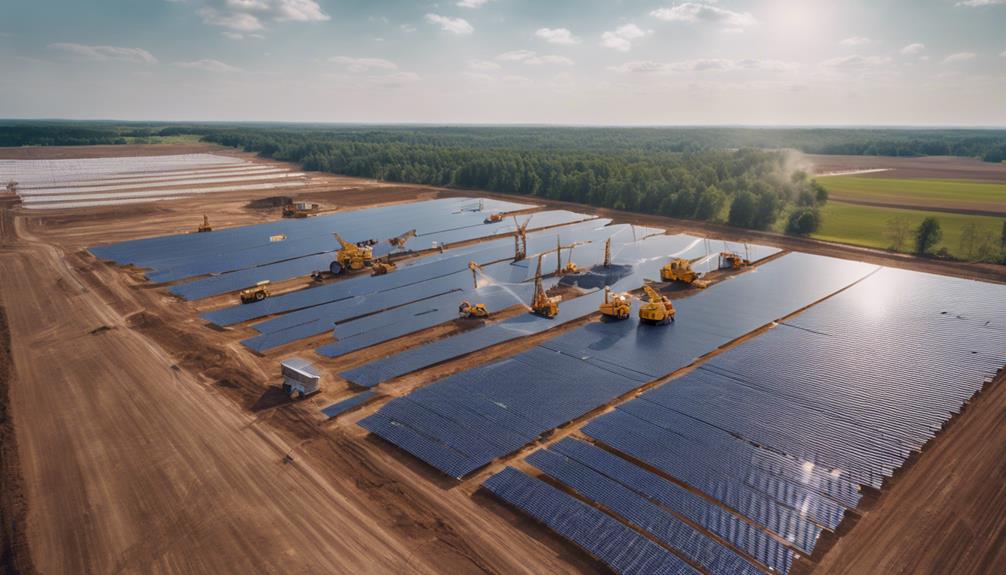
For best energy production in solar farm construction, strategic site selection is vital. When implementing solar farm construction best practices, consider the following:
- Optimal Site Selection: Choose locations with high solar irradiance and minimal shading to maximize energy production efficiency.
- Panel Tilt and Spacing: Properly adjust panel tilt, orientation, and spacing to enhance solar capture efficiency throughout the year.
- Advanced Technologies: Utilize Battery Energy Storage Systems (BESS) and optimized mounting structures to improve overall solar farm performance.
- Compliance with Standards: Adhere to industry regulations and standards during construction to guarantee long-term reliability and sustainability of the project.
Frequently Asked Questions
How Much Can You Make per Acre on a Solar Farm?
You can potentially earn between $21,250 to $42,500 annually per acre on a solar farm. This revenue is influenced by factors like location, solar irradiance, land costs, and energy prices, with proper planning for long-term returns.
How Much Does a 1 MW Solar Farm Cost?
You're looking at around $1 million to $1.5 million for a 1 MW solar farm. Solar panels are about 25-30% of the cost. Don't forget expenses like land, permits, and ongoing maintenance. Detailed financial planning is key.
What Is the ROI of a Solar Farm?
The ROI of a solar farm varies based on factors like location, size, and financing. With stable electricity prices, reduced operational costs, and government incentives, solar farms typically provide a steady 5-10% ROI over 25-30 years.
How Do Solar Farm Developers Make Money?
To make money as a solar farm developer, you're like a savvy investor planting seeds in a sunny field. You earn by selling electricity, RECs, or SRECs, tapping into tax incentives, and offering asset management services.
What Are the Best Practices and Advancements in Solar Farm Construction that Can Help Prevent the Need for Repairs?
When it comes to preventing the need for solar farm repair best practices, there are several advancements in construction that can help. Using durable materials, proper installation techniques, and regular maintenance can all contribute to prolonging the lifespan of a solar farm and minimizing the need for repairs.
Conclusion
As you commence on the journey of solar farm construction, remember that each panel represents a beacon of hope for a brighter, more sustainable future.
By integrating the best practices and advancements outlined in this guide, you aren't just constructing a solar farm, but a symbol of progress and innovation.
Embrace the challenge, harness the power of the sun, and let your solar farm shine as proof of your commitment to a greener world.
